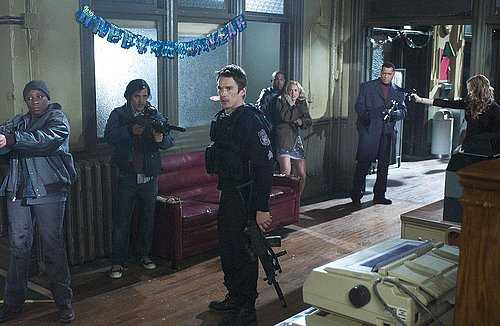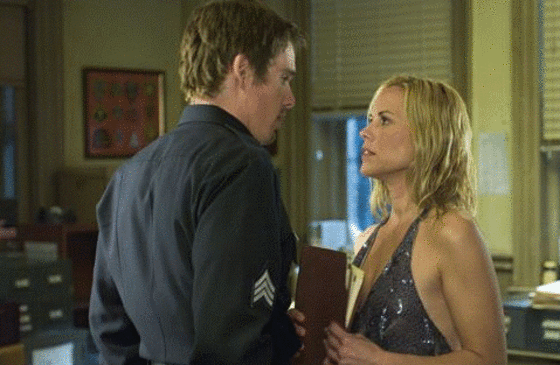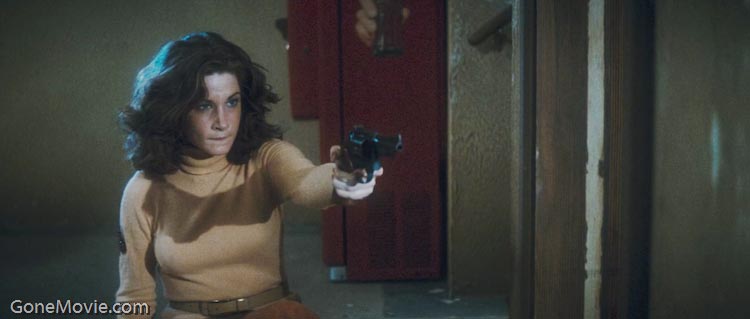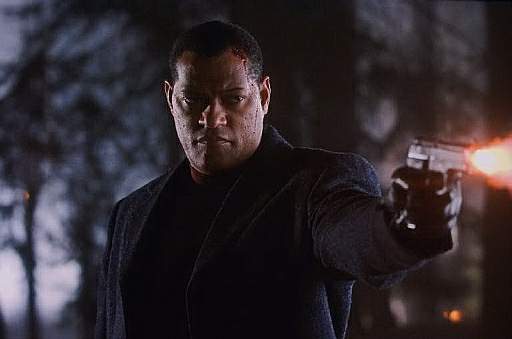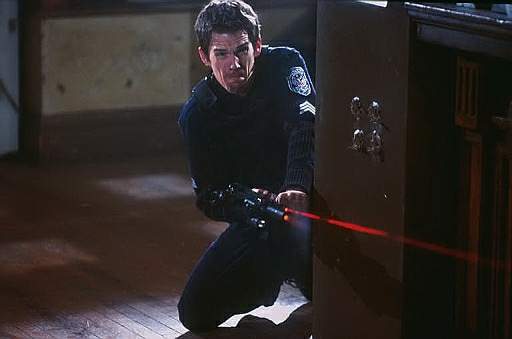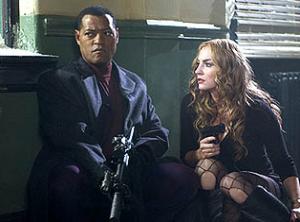From the Chicago Reader (January 21, 2005). — J.R.
Assault on Precinct 13
*** (A must-see)
Directed by Jean-Francois Richet
Written by James DeMonaco
With Ethan Hawke, Laurence Fishburne, John Leguizamo, Gabriel Byrne, Maria Bello, Brian Dennehy, Drea de Matteo, and Ja Rule
John Carpenter’s first solo feature, Assault on Precinct 13 (1976), is an effective low-budget genre piece — a perfectly proportioned, highly suspenseful action story about a few individuals under siege. It’s derived in part from Howard Hawks’s 1959 western Rio Bravo: Carpenter directly quotes from the dialogue and action, and he jokily adopts the pseudonym of John T. Chance, the name of John Wayne’s character, as the credited editor. The film is also influenced by claustrophobic horror movies such as The Thing (which Carpenter subsequently remade), The Birds, and Night of the Living Dead, especially their depiction of how unstable group dynamics are affected by an impersonal menace.
After most of the employees of a police station in a Los Angeles ghetto have moved to a new building, the station is attacked by a vengeful gang that uncannily expands into a mob, to the accompaniment of Carpenter’s relentlessly minimalist, percussive synthesizer score. A black rookie named Bishop and two white secretaries are the only remaining staff, and once Bishop realizes they can’t survive without help, he frees two prisoners, one black, one white — both hardened criminals en route to the state pen. More improbably, the four gang members who first attack the station are of different races and ethnicities, though they quickly metamorphose into a faceless collective monster of no clear race or ethnicity — making it easier for us to accept the indiscriminate slaughter of one of them after another as they try to climb through the windows. Following Hawks’s ethic of relativity, virtually everyone inside turns out to be a good guy in some way, and almost everyone outside either proves to be evil or gets killed. As Dave Kehr put it in the Reader‘s capsule review, the movie’s “short on motivation but long on paranoia.”
Properly speaking, the remake, which has plenty of its own kind of paranoia, is neither a western nor a violent crime thriller but a war movie — something the original is implicitly — especially given its militaristic maneuvers and hierarchies. The setting is the outskirts of Detroit, which has been nearly paralyzed by a blizzard on New Year’s Eve. The gang has been replaced by cops — most of the force — who’ve been in cahoots with a mob boss and killer named Bishop (Laurence Fishburne). He’s being held temporarily at the station, and they’re determined to kill him so he won’t expose them in court. They’re also determined to kill everyone else in the station, any one of whom could rat them out.
Carpenter’s movie is a very efficient thriller, but its efficiency depends on our acceptance of the legitimacy of authority. The impact of this movie is predicated on the illegitimacy of authority. Director Jean-Francois Richet, who grew up in one of the projects on the outskirts of Paris, shot his first feature, État des lieux (1995), on a $20,000 budget, which he’d accumulated by gambling his unemployment check at a local casino. But he’s better known for Ma 6-T va crack-er (1997), an explosive and eclectic feature whose title is translated in Universal’s press notes for Assault as Crack City, though “My 6-T Goes Bang” seems more accurate and more appropriate. It depicts a series of violent skirmishes between the police and some young people who live in the projects, and it too qualifies as a war film.
It was banned from French screens as a danger to public safety, though it’s now available on a French DVD (and with English subtitles on a Hong Kong DVD). Critic Nicole Brenez describes it in the online Senses of Cinema as among the best films of the 90s and as Richet’s version of Sergei Eisenstein’s Strike: “In Ma 6-T va crack-er — a masterpiece of that most perilous kind of cinema, namely militant, political cinema — Richet finds the means to formally reconcile Jean Renoir and Eisenstein, Max Ophüls and Public Enemy. A call to revolt that returns us to the fundamentally radical bases of the [1793 French] Republican Constitution.” Richet has also become a highly successful music producer — the sound track album of Ma 6-T went gold — and I suspect this is what brought him to the attention of Hollywood.
Richet doesn’t get a script credit on the remake of Assault on Precinct 13 — that goes to James DeMonaco. But the original has been given a political spin: the character named Bishop, though still black, is now the most important prisoner instead of the cop in charge, and the two other important black characters are both prisoners in the precinct, not cops. The main cop at the precinct is not a rookie but a former undercover drug agent named Jake (Ethan Hawke), who lost his female partner in a shoot-out — an event shown in the film’s prologue — and has been blaming himself ever since.
The core story in both versions is the same — an honest cop and an unrepentant killer find some measure of mutual respect as they work together and then save each other’s lives. But the moral context is quite different. The honest cop is tainted because he once posed as a drug dealer and because he’s now a self-pitying pill popper; the unrepentant killer, nonchalantly focusing on a crossword puzzle throughout much of the mayhem, ultimately seems no worse than anyone else who has to kill to save himself and less hypocritical than the corrupt cops trying to kill him. Richet’s mise en scène also stresses the difference in the performance styles of Hawke and Fishburne rather than their similarities. Hawke moves his body and features as spastically as a monkey, an effect heightened by a string of jump cuts in the prologue; Fishburne is a master of smooth economy and stasis, acting mainly with his eyes.
The metaphysical cast of the story remains Hawksian to the extent that the besieged characters are still more sympathetic than the besiegers — their teamwork retains an ethical cast, unlike the teamwork of the crooked cops (headed by Gabriel Byrne). But because this is more overtly a war film, almost everything else is changed. Within the context of police corruption, the prisoners are now political prisoners. One of the besieged female characters (Maria Bello) is now Jake’s psychiatrist rather than a secretary, adding an upper-crust character to the mix and making the characters inside the station less working-class and more representative of society as a whole. Gone is a pivotal figure in Carpenter’s film, a father whose little girl is killed by a gang member and who kills the hood in revenge before turning up at the station and setting off the siege. An awkward prop, he’s promptly forgotten.
My preference for the remake over the original has more to do with its harsh representation of contemporary state corruption and its unsentimental ethical distinctions than with its success as a thriller, though its violence packs a bigger punch than Carpenter’s. Both films generate suspense, but Carpenter’s generates more because it reduces its representations of society and humanity to the most familiar stereotypes, allowing us to eschew analysis and focus on events. (Carpenter would show much more political savvy in his satirical 1988 SF thriller They Live.)
Some reviewers have faulted Richet for failing to meet Carpenter’s standards. Their implication is that a genre film should be mindless — Richet shouldn’t be throwing in ethical nuance and relativity or assessing today’s world. I’m reminded of Laura Riding’s 1936 essay about bullfighting, written while she was an American expatriate: “So long as other people observe the taboos Americans impose on them, Americans treat them with the familiarity with which they treat one another. When the taboos are not observed, Americans go ‘ugly’: they treat other people as strangers. Familiarity is the highest compliment in the American scale of compliments.” In these terms, what I’d like to say to Richet is, “Welcome, stranger.”

